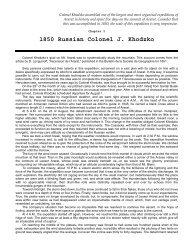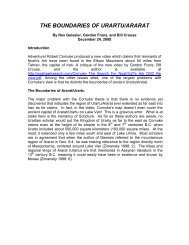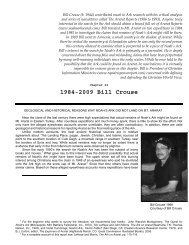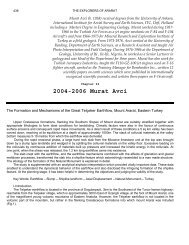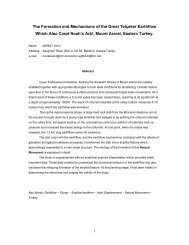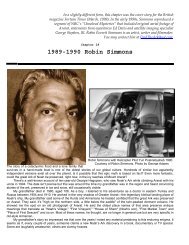1876 British Viscount & Ambassador James Bryce - Noah's Ark Search
1876 British Viscount & Ambassador James Bryce - Noah's Ark Search
1876 British Viscount & Ambassador James Bryce - Noah's Ark Search
Create successful ePaper yourself
Turn your PDF publications into a flip-book with our unique Google optimized e-Paper software.
174 THE EXPLORERS OF ARARAT<br />
one on the spot who could tell us much about them, and I doubt if there is any one who knows much. The stock of<br />
printed books is quite small, not reaching 2000, and of course the great majority are in Armenian, most of the newer<br />
ones in Russian. There seems to be little ground for hoping that any Greek or Latin manuscripts, unless, possibly, of<br />
late ecclesiastical writers, remain to be discovered here; it is rather to Orientalists that researchers into the libraries of<br />
the Armenian monasteries are to be recommended. The treasure, or, as we should say, the sacristy, in which the holy<br />
relics that constitute the great glory of Etchmiadzin are kept, is a new building at the east end of the church. Unhappily<br />
we could not gain admittance, owing to a cause which might seem to cast a painful light on the want of security, or at<br />
least of confidence, among even the respectable ecclesiastics of this country. There is but one key to the treasury, and<br />
that key is kept by the patriarch, who carries it with him wherever he goes. He was then in a cool mountain retreat<br />
some miles away on the slopes of Ala Göz, and we were therefore obliged to forego the hope of seeing the head of the<br />
holy spear wherewith the Roman soldier pierced the side of Christ. It is asserted to have been brought to Armenia by<br />
Thaddeus the Apostle, and has therefore a far more respectable pedigree, so to speak, than the rival “holy lance”<br />
which the Crusaders discovered at Antioch with such magnificent results, or than that which Sir John Maundeville tells<br />
us he saw at Constantinople in the possession of the Eastern Emperor, not to speak of other claimants. In this<br />
treasure-house there is also a fragment of Noah’s <strong>Ark</strong>, obtained, according to the legend stated in an earlier chapter,<br />
by the monk St. Jacob; and, what is the most curious of all, a withered mummy hand enclosed in a casing of silver,<br />
which purports to be the very hand of St. Gregory the Illuminator. This hand is actually used to this day in the<br />
consecration of every patriarch, who being touched by it receives the grace, as it were, direct from the founder of the<br />
Armenian Church. It is an instance of the carrying out, on its physical side, of the doctrine (I will not say of apostolic<br />
succession) of the transmission through earthen vessels of spiritual gifts, and their communication by physical means,<br />
which one is startled to find still in full force in an important and respectable branch of the Christian Church. In the<br />
middle ages nothing would have seemed more natural or impressive; in the nineteenth century it looks a little different.<br />
Besides the cells of the monks, who number from twenty to thirty, there are, on the west side of the great square,<br />
apartments for the patriarch and for the archbishops, bishops, and archimandrites from other monasteries, who are<br />
frequently to be found here, consulting him on the affairs of their churches, or attending the general and supreme<br />
synod, which sits, almost in permanence, under his presidency. Finally there is the seminary, a sort of school or<br />
college for the education of young Armenians chiefly, but not exclusively, with a view to their entering the priestly<br />
office. There were about eighty boys or young men then attending, who are of course lodged in the monastery, and for<br />
the most part remain in it from the beginning to the end of their education, coming often from great distances. Among<br />
those present in the dining hall some were from the heart of Persia, others from Cilicia, others from all sorts of places<br />
scattered through Asia Minor. The well-marked national type of countenance, the dark eyes and straight, black hair,<br />
came out strongly; and the quick intelligence of many of the faces was no less characteristic. The school labors under<br />
serious disadvantages from the difficulty of procuring competent teachers, and the state of blank ignorance in which so<br />
many pupils come. A magazine called ‘Ararat’ has recently been established; it is printed at the monastery, and of<br />
course in Armenian; nor is the press of Etchmiadzin idle in producing educational manuals, the class of books which<br />
are (strange as a <strong>British</strong> parent may think it) at present most scarce among the Armenians of these countries.<br />
It was a Friday, but they made no difficulty about giving us a substantial meat supper, some one probably<br />
knowing that the English do not regard those church fasts which are so prodigiously important in these countries. It is<br />
really quite a new light to a Westerner to find that the chief difference, in the wilder places, between Christians,<br />
pagans, and Mohammedans, consists in the times or rules of fasting. There seemed to be very few other guests in<br />
convent at the time of our visit. Probably it was the dead season; the heat was oppressive; there were fevers about;<br />
the Patriarch, to confer with whom most of the ecclesiastical visitors come, was absent in the mountains. He is named<br />
Kevork (George).<br />
Now, like almost all the great old shrines, like Santiago, Einsiedeln, St. David’s, Loretto, it has lost this source of<br />
wealth, and has also lost the visitors who halted at it as they passed along what was once the great trade route from<br />
Trebizond by Erzerum and Erivan to Tavriz and Northern Persia. The trade from Persia to the Black Sea now goes<br />
entirely through Turkish territory, I suppose in order to avoid Russian custom-houses, by way of Bayazid on the<br />
southwestern side of Ararat. The village of Vagarshabad, lying a few hundred paces from the monastic fortress, is<br />
quite an insignificant place, with scarcely any trace of its former greatness. Only one mass of ancient brick building<br />
marks the place where there once stood, according to Armenian historians, 20,000 houses, the place where Tiridates<br />
reigned, at the time of his conversion, over a powerful kingdom. These Oriental cities, being mostly built of unburnt<br />
brick, and without great public structures, perish very swiftly, and leave little trace behind. Usually only the churches<br />
remain; and so here, near the convent, here stand two churches, probably more ancient than the cathedral itself, those<br />
of St. Rhipsime and St. Caiana, who were martyred in the time of Tiridates. Rhipsime was a virgin of exquisite beauty.<br />
Accompanied by a band of maidens, she had fled from Rome to escape the addresses of the reigning emperor, whom,<br />
as a pagan, she could not espouse. Tiridates was equally smitten by her charms, and when she refused him for the<br />
same reason, he put her to death with hideous tortures, and killed at the same time her nurse Caiana.<br />
The present condition of the monks leaves much to be desired, as far as knowledge and education goes, but in<br />
general their monastic life will fairly bear a comparison with that of most Western as well as Russian foundations. Their<br />
dress is becoming: it consists of a long black robe of a thin serge or tissue, not so thin as crape, and a peaked cap,<br />
from which a sort of veil of the same material falls back over the neck and shoulders. On the whole they impress a



